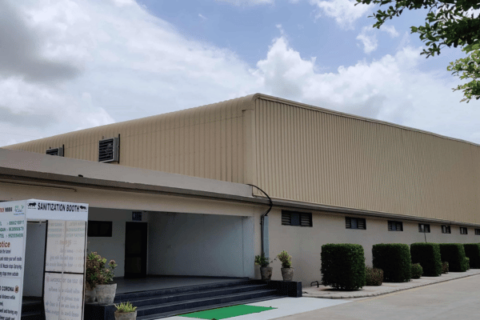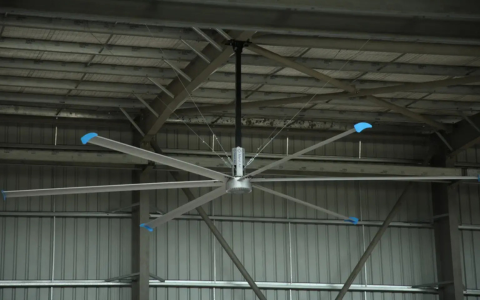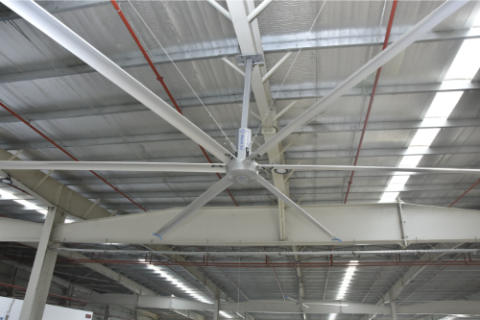During the cold season, in indoor spaces, colder air is mainly experienced in the lower part while warm air is present near the ceiling side. This type of situation is called thermal stratification. It mainly causes discomfort in areas like warehouses, plants, and commercial buildings. Here, heating systems have to work harder to maintain the proper temperature and it requires high energy costs. However, HVLS fans work as a powerful and effective solution in this condition. Let us know how these fans help in combating this thermal stratification.
What is Destratification
Destratification is a type of process that is done to remove thermal stratification. In it, air is separated into different layers based on the temperature during the winter season. Warmer air mainly accumulates near the ceiling while cooler air stays near the floor. Here, by doing desertification, this separation is removed and uniform air distribution is established. It is mainly done with HVLS fans.
How HVLS Fans Help in Destratification
HVLS fans are mainly made with large blades and they rotate gently to move the air around. During destratification, these fans run in a slow momentum and circulate air to push the hot air downward. Some of those fans also come with reverse rotation capability to push warm air from the ceiling and mix it with the cooler air on the floor. This can form a very balanced and pleasant indoor atmosphere.
For instance, the temperature in a warehouse on the upper side is 96°F and 54°F on the floor. In that case, if we switch on the HVLS fan then it will slowly make the uniform 75°F temperature throughout the warehouse.
As it works slowly, air drafts are prevented and people do not feel a noticeable breeze. It distributes heat without causing any type of discomfort.
Benefits of Destratification with HVLS Fans
Energy Efficient
HVLS fans significantly reduce the workload of heating systems by effectively circulating above-trapped warm air into a downside. With this, heating systems do not have to use a lot of energy to maintain a consistent temperature, and you can save a significant amount of energy.
Enhance Comfort
With destratification, you can create an even temperature throughout the space without strong wind and eliminate very cold spots near the floor. It improves the comfort of occupants and even imparts higher productivity to the people working in that facility.
Versatility
These HVLS fans are used in numerous applications which include industrial facilities, retail spaces, agricultural buildings, and recreational centers to eliminate thermal stratification and to form a uniform ambiance.
Cost Saving
It reduces energy consumption and electricity bills which are directly related to the cost. Plus, quality HVLS fans give an amazing performance for a long time and become a cost-saving choice.
What are the Common Applications of HVLS Fans for Destratification
Here are some common applications of HVLS Fans for destratification, including:
- Warehouses and Distribution Facilities: In the case of warehouses and distribution facilities, de-stratification is necessary for achieving constant temperatures, decreasing energy waste and increasing employee comfort.
- Factories and Manufacturing Facilities: HVLS fans create a more consistent environment for employees and control temperature variation of products through the mixing of warmer air with cooler air.
- Retail or Commercial Spaces: Stop cold spots and draughts by installing HVLS fans, and more importantly achieve a more comfortable environment for the consumer, leading to additional selling opportunities.
- Gymnasiums & Sports Venues: HVLS fans will provide more consistent temperatures, ensuring the comfort of the athletes and the spectators of any event.
- Agricultural Buildings: In livestock buildings, use of HVLS fans provides for more constant control of temperature as they reduce heat spots and guarantee more continuous heat flow. Positive comfort for livestock leads to positive reproductive and productive results.
Practical Tips for Maximizing HVLS Fan Efficiency
Here are some practical tips for maximizing HVLS fan efficiency, including:
Installation and placement
- Size and height: Select the proper blade diameter for your space, and install the fans properly. Distribute the fans evenly and maintain a distance from walls, lights, and other obstacles such as sprinkler systems to increase airflow potential.
- Spacing: Follow the manufacturer’s recommendations for spacing when utilizing multiple fans to avoid locking two streams of air together to create overlap and turbulence.
- With coordination of other systems: HVLS fans will, in conjunction with your HVAC systems, better distribute conditioned air throughout your space; this reduces the load on the HVAC systems and saves you energy consumption.
Operating settings
- Seasonal direction: Using your fans counter-clockwise in the summer and clockwise, at a lower speed, in the winter.
- Variable speed wayfinding: You can vary the fan speed according to temperature, humidity, location, and occupancy, using only that energy for the variable conditions while reducing the motor running time.
- Smart automation: If your fans can interface with a building management system (BMS), you can set your fans to automatically determine operation based on sensor data, or a pre-set schedule.
Conclusion
Destratification with the help of HVLS fans proves an effective strategy to enhance comfort, reduce energy consumption, and remain cost-saving during the winter season. In various indoor places, these fans create a uniform temperature distribution by gently circulating air. So, if you have a large indoor place without HVLS fans, then it is time to bring quality ones from Marut Air and stay away from thermal stratification.
People Also Ask About How HVLS Fans Circulate Warm Air
Question 1. How do HVLS fans help circulate warm air during winter?
Answer. In winter, HVLS fans circulate warm air by using their large blades to move warm air, which naturally rises and accumulates at the ceiling, downward to the occupied zone of a building.
Question 2. What types of facilities benefit most from destratification with HVLS fans?
Answer. Facilities such as warehouses and distribution centers, manufacturing plants, barns and livestock shelters, greenhouses, gyms and fitness centers, shopping malls, sports complexes and arenas benefit the most from destratification with HVLS fans.
Question 3. What is the ideal installation height for HVLS fans in large buildings?
Answer. The ideal installation height for HVLS fans in large buildings is typically between 12 and 30 feet above the floor for safety and effective airflow.





